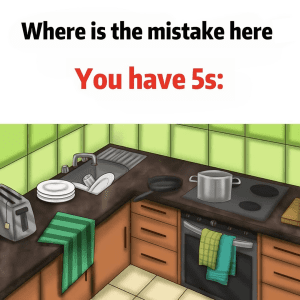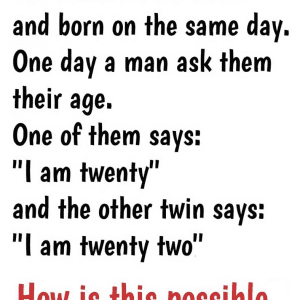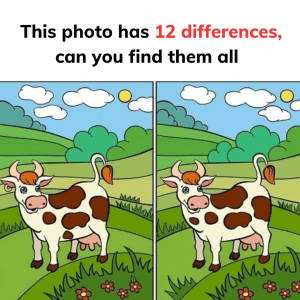Puzzles are more than just fun—they’re an excellent way to train your brain. Whether it’s an image puzzle where a small piece is missing, or a complex riddle that requires logical thinking, these challenges are designed to test our observational skills and analytical thinking. In this article, we’re going to dive into a classic puzzle where you must match a missing corner piece from a set of options. Think you’re up for the task? Let’s explore why these puzzles are so tricky and how you can improve your skills to solve them like a pro!
Why Small Details Make These Puzzles Tricky

One of the main reasons why image puzzles like this one are challenging is because of the tiny details that can make or break your solution. While it’s tempting to focus on the general shape of the missing piece, the key to solving these puzzles lies in the finer details. Subtle differences in angles, textures, and shadows are often the deciding factors between a correct and incorrect match.
In this type of puzzle, you must pay close attention to every single aspect of the image—nothing can be overlooked. Even the smallest discrepancy, like a slight change in texture or an angle of the tear, can throw you off. This challenge requires not only accuracy but also patience as you carefully observe and match the smallest clues.
Common Mistakes People Make in Matching Puzzle Pieces
When attempting puzzles that demand a sharp eye for detail, many people make the following common mistakes:
Focusing Only on the Outline
It’s easy to assume that a piece with a similar outline is the correct fit. However, in detailed puzzles, even a slight mismatch in the curve or angle can make a piece incorrect. Always remember to look beyond the outline and consider the entire context.
Ignoring Shadows and Colors
In puzzles where the background is involved, shadows and color variations can reveal crucial clues. Overlooking these elements is a common mistake that often leads to choosing the wrong piece. Colors and textures matter just as much as shape and size in these challenges.
Rushing Through the Options
While it might work for simpler puzzles, rushing through the options is a surefire way to make a mistake. Puzzle-solving requires focus and careful analysis. Skimming through the options without taking the time to examine each piece thoroughly can cause you to miss the subtle clues needed for a correct match.
Step-By-Step Guide to Solving the Puzzle
Now that we’ve covered the common mistakes, let’s dive into how you can approach this particular puzzle step by step. By breaking down the process, you’ll be able to solve any puzzle that comes your way.
Analyze the Shape and Angle of the Tear
The first step is to closely examine the torn area of the main image. Take note of the specific shape and angle of the tear. The curve, edges, and texture in this section will serve as your guide as you compare the pieces.
Examine Each Piece Thoroughly
Next, take a good look at each piece in the set. You’ll want to compare them against the shape and texture of the tear in the image. Pay attention to the edges, angles, and any other distinguishing features that could make or break the match.
- Piece 1: Upon closer inspection, Piece 1 appears close in shape but there’s a small mismatch in the angles and curves of the tear. Additionally, the texture and color of the sand don’t align well with the main image, which means this isn’t the correct choice.
- Piece 2: Piece 2 has a much better alignment. The outline matches closely, and the sand texture and shadow details also match with the torn area. This piece seems like the most likely candidate for the correct match.
- Piece 3: While the outline of Piece 3 looks similar, the angle of the tear is slightly off. The curve doesn’t align with the image, and some elements in the sand appear different, making this piece an unlikely fit.
- Piece 4: Piece 4 has some similarities but doesn’t match in terms of shadows or texture. When placed next to the torn area, it’s clear that it doesn’t fit as seamlessly as Piece 2.
Final Choice Based on Details
After carefully analyzing each option, Piece 2 emerges as the most accurate fit. Its shape, texture, and alignment with the torn area make it the best choice for completing the image.
The Solution: Piece 2 is the Right Match

After going through each piece and examining the fine details, the solution is clear: Piece 2 is the correct match for the torn corner. The curve of the tear aligns perfectly with the piece, and the texture and color of the sand are an exact match. This piece completes the image seamlessly and demonstrates the importance of looking at every detail before making a decision.
Encouraging Readers to Test Their Observation Skills Further
Did you get it right? If so, great job! If not, don’t be discouraged—these types of puzzles are all about practice. The more you work on puzzles like this, the sharper your observation skills will become. Remember, attention to detail is a skill that improves over time, and puzzles are a fantastic way to exercise your mind.
We’d love to hear about your experience with this puzzle. Which piece did you initially choose, and how did you narrow down the options? Share your thoughts in the comments below! And don’t forget—challenging yourself with more puzzles is a great way to improve your logical thinking and attention to detail.
Keep puzzling and keep honing those skills! The more you practice, the better you’ll become at spotting even the tiniest details that can make all the difference. Happy puzzling!


